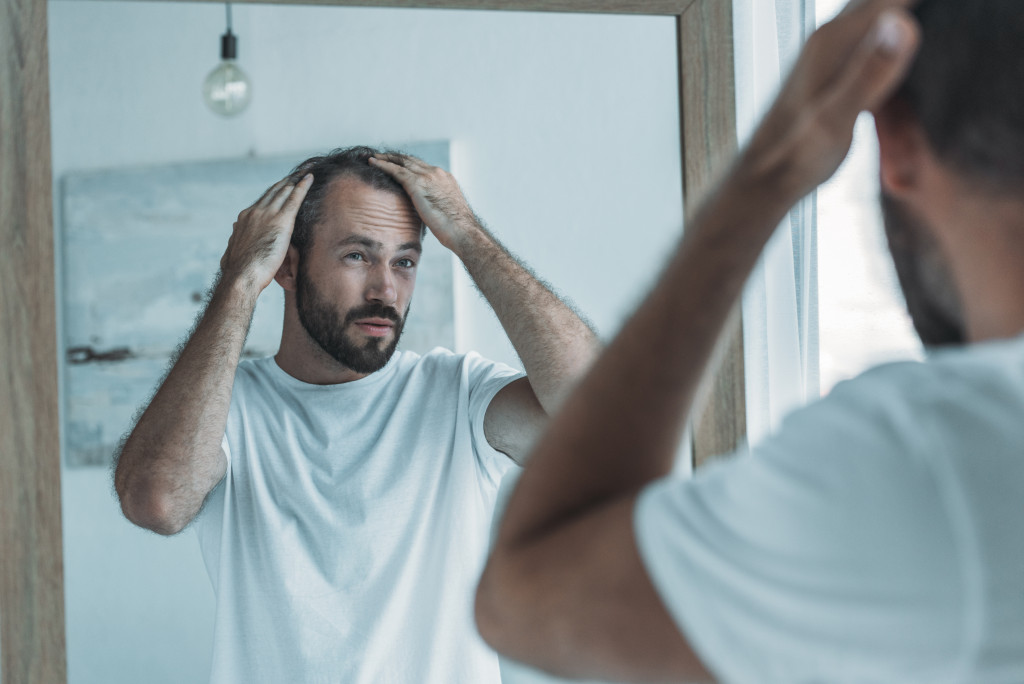Male pattern baldness is the gradual loss of hair on men’s scalps. Male pattern baldness, also known as androgenetic alopecia, typically begins during adulthood in men, when their hormone levels change. Aside from the hormonal changes, genetic factors contribute to the likelihood of androgenetic alopecia.
How can you tell if you have male pattern baldness? Hair loss that originates at the temples is a typical sign of androgenetic alopecia. For some men, a single bald spot on the head develops. Others will have a noticeable recession of the hairline that forms an M-like shape. Mostly, the hairline continues to recede until most or all of it is gone.
Research has shown that male pattern baldness is linked with androgens or male sex hormones. Regulating hair growth is one of androgens’ functions. Hormones and genetics contribute to the gradual shrinking of hair follicles on the scalp — small cavities found at the base of each hair strand. Because of this shrinkage, hair grows gradually shorter and shorter and becomes finer until it finally ceases to grow at all.
The Myths About Male Pattern Baldness
1. Excessive use of hair products like hair dyes and frequent wearing of hats cause baldness
There actually is no scientific evidence attesting to these as causes of male pattern baldness. Using hair dye with bleach can weaken the hair, making it prone to breakage, but it has not been studied to cause baldness directly. Similarly, wearing hats can cause friction to the head, which can also cause weakening and breakage of the hair, but hats are not directly linked to hair loss.
2. Only older men will go bald
Male pattern baldness typically occurs in adulthood, but it can begin during the teenage years.
3. Stress causes hair loss
While it might be true that stress can cause hair loss, it’s not from the typical daily stress that we all experience. The kind of stress that contributes to hair loss in men is more psychological or medical. Impaired coping skills or interventions such as chemotherapy are examples of each. Also, once the stressor is identified and addressed, hair will normally grow back. Hair loss in male pattern baldness is not reversible.
4. Genetic hair loss is passed down through your mother’s side of the family
Male pattern baldness can be passed down by either (or both) parents, not just from the maternal side of the family. Genetics plays a significant role. Males with first and second-degree relatives afflicted with male pattern baldness are likely to have the condition.

5. Massaging your scalp can prevent male pattern baldness
While it’s true that massaging the scalp can stimulate the flow of blood to the hair follicles, doing so only benefits existing hair, and will not promote the growth of new hair. Genetic hair loss is, unfortunately, permanent.
Can You Prevent Male Pattern Baldness?
Some theories indicate stress as a significant contributor to hair loss because it elevates the production of sex hormones in the body. Of course, you can diminish stress by engaging in relaxing activities, such as breathing exercises, listening to calming music, walking, reading, etc. However, and unfortunately, there is no scientifically proven way to prevent androgenetic alopecia because this condition is mainly genetic.
Over-the-counter hair loss treatments, such as finasteride, are known to prevent hair loss or promote hair growth in men with mild to moderate symptoms of male pattern baldness. Such treatments block the hormone that’s linked to hair loss in men. It is, however, still ideal to consult with hair specialists such as the professionals in aesthetics clinics like Freia Medical. Some studies have shown that finasteride has been linked to a diminished sex drive, along with other possible side effects, and that symptoms can persist even after discontinuing the medication.
Medical treatment for male pattern baldness is not needed unless other health conditions known to cause hair loss are present. However, there can be treatments available for those who desire to regain the appearance of a full head of hair or those who may be psychologically impacted by the loss of their hair. Hair transplants, wigs or hair weaves, pharmacotherapy, and counseling are all options available to men with androgenetic alopecia. Again, consulting with hair treatment professionals before beginning any intervention is always recommended.
Although hair loss is a natural part of the aging process for a large percentage of the male population, it can have a psychological or emotional impact. Also, keep in mind that sudden, drastic, or unexpected hair loss can be indicative of an underlying health condition that might require prompt medical attention.

